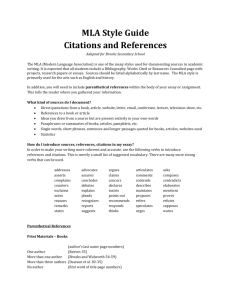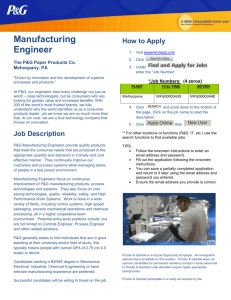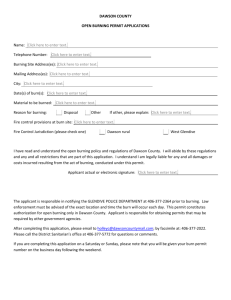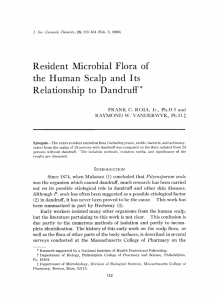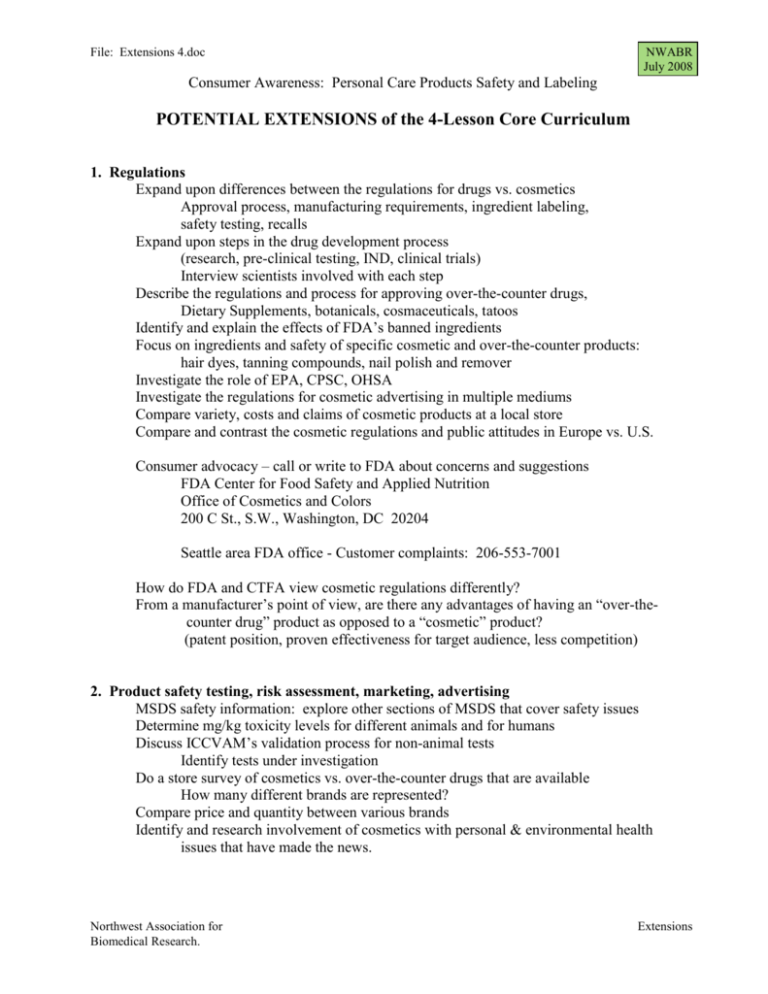
File: Extensions 4.doc
NWABR
July 2008
Consumer Awareness: Personal Care Products Safety and Labeling
POTENTIAL EXTENSIONS of the 4-Lesson Core Curriculum
1. Regulations
Expand upon differences between the regulations for drugs vs. cosmetics
Approval process, manufacturing requirements, ingredient labeling,
safety testing, recalls
Expand upon steps in the drug development process
(research, pre-clinical testing, IND, clinical trials)
Interview scientists involved with each step
Describe the regulations and process for approving over-the-counter drugs,
Dietary Supplements, botanicals, cosmaceuticals, tatoos
Identify and explain the effects of FDA’s banned ingredients
Focus on ingredients and safety of specific cosmetic and over-the-counter products:
hair dyes, tanning compounds, nail polish and remover
Investigate the role of EPA, CPSC, OHSA
Investigate the regulations for cosmetic advertising in multiple mediums
Compare variety, costs and claims of cosmetic products at a local store
Compare and contrast the cosmetic regulations and public attitudes in Europe vs. U.S.
Consumer advocacy – call or write to FDA about concerns and suggestions
FDA Center for Food Safety and Applied Nutrition
Office of Cosmetics and Colors
200 C St., S.W., Washington, DC 20204
Seattle area FDA office - Customer complaints: 206-553-7001
How do FDA and CTFA view cosmetic regulations differently?
From a manufacturer’s point of view, are there any advantages of having an “over-thecounter drug” product as opposed to a “cosmetic” product?
(patent position, proven effectiveness for target audience, less competition)
2. Product safety testing, risk assessment, marketing, advertising
MSDS safety information: explore other sections of MSDS that cover safety issues
Determine mg/kg toxicity levels for different animals and for humans
Discuss ICCVAM’s validation process for non-animal tests
Identify tests under investigation
Do a store survey of cosmetics vs. over-the-counter drugs that are available
How many different brands are represented?
Compare price and quantity between various brands
Identify and research involvement of cosmetics with personal & environmental health
issues that have made the news.
Northwest Association for
Biomedical Research.
Extensions
File: Extensions 4.doc
NWABR
July 2008
POTENTIAL EXTENSIONS of the 4-Lesson Core Curriculum
3. Chemistry of cosmetics
Identify ingredients associated with special functions (e.g., sun screens, anti-dandruff
shampoos, antiperspirants, insect repellents, muscle creams, etc)
Design lab investigations comparing homemade and commercial products
Draw chemical structures of ingredients in personal care products
Discuss types of oils (saturated, unsaturated) and waxes and their properties in emulsions
Obtain MSDS information for all ingredients in a product
Study MSDS’s for physical properties of ingredients
Discuss ingredients and their effect on the environment through manufacturing & disposal
Compare preservatives and shelf life in different products (inquiry project)
Study fragrances and extraction procedures
Identify chemical structures for various fragrances (banana, lemon, strawberry, etc.)
Investigate lip gloss melting points; separate colors by chromatography
4. Biology: A focus on skin
Expand upon skin structure and function
Study hair: ethnic differences, hair growth/removal, hair color, cosmetic products for
treating hair
Study nails: growth, diseases, cosmetic products and safety (polishes/removers)
Evaluate cosmetic claims based on knowledge of physiology
Study skin pigmentation and tatoos
Evaluate the biological function of “active ingredients” for various products:
anti-aging and anti-wrinkle creams, sunscreens, skin lighteners, exfoliants, insect
repellants, hair colors
Research transdermal drugs/OTC products (e.g., smoking cessation patches, muscle
relaxants, contraceptives, etc)
Research causes of skin diseases (psoriasis, dermatitis [allergy], acne, cutaneous lupus)
Define and find cosmetic ingredients that are carcinogens, mutagens and teratogens
Investigate the science supporting aromatherapy claims
5. Careers
Biologists
Toxicologists
Microbiologists
Dermatologists
Chemists – analytical, synthetic
Formulation experts
Clinical Research Professionals (associates or coordinators)
Veterinarians
Medical writers, grant writers, regulatory writers
Patent attorneys for biotech/pharmaceutical products
Interview a scientist in any of the specialties listed above
Info on becoming a cosmetic chemist, http://chemistscorner.com/articles/
www.ls-central.com = career trees, videos with Seattle scientists
Northwest Association for
Biomedical Research.
Extensions
File: Careers, ed.doc
NWABR
July 2011
It takes many scientists to create a lotion!
Biologists
Analytical chemists
Synthetic chemists
Formulation chemists
Toxicologists
Microbiologists
Research Associates
Veterinarians
Lab animal technicians
Statisticians
Clinical Research Associates
Manufacturing Engineers
Technical Packaging Specialists
Quality Assurance Professionals
Regulatory Specialists
Consumer Affairs Professionals
Training to be a Scientist
Science:
biology
chemistry
toxicology
microbiology
Math:
making solutions
evaluating data
Public Speaking
Computers:
molecular modeling
graphing
data gathering
Writing:
© Copyright 2008 Northwest Association for
Biomedical Research. All rights reserved.
lab book
reports
presentations
publications
Careers
File: Dandruff Genomics.doc
NWABR
July 2008
The Scientist, Volume 22 | Issue 5 | Page 75
http://www.thescientist.com/article/print/54595/
Trends in the pharma, biotech, and life sciences industries
Dandruff Genomics
At Procter & Gamble, Thomas Dawson has led the charge to put more biology in every bottle of shampoo.
When Thomas Dawson first interviewed for a position at Procter & Gamble 10 years ago, he was struck by
how clean the hallways were in comparison to the university laboratories where he had spent most of his
career. "Well," his host responded, "we are a cleaning products company."
Inside the glass-fronted lobby of the company's Miami Valley Innovation Center, nestled along a wooded
stretch of the Miami River near Cincinnati, Ohio, a bronze plaque commemorates the development of Tide
laundry detergent. The restrooms are all outfitted with household paper towel dispensers loaded with rolls
of Bounty.
The company was founded by a soapmaker and a candlemaker in 1837, but over the last decade, biologists
like Dawson have been redefining exactly what it means to be a "cleaning products company" - beginning
with one of their flagship products, Head & Shoulders, the leader in the $6 billion anti-dandruff shampoo
market.
Head & Shoulders took more than 10 years to develop as chemical engineers screened over 2000 chemicals
before stumbling upon pyrithione zinc, an anti-microbial compound that works particularly well on the
dandruff-causing fungi in the genus Malassezia. The new shampoo hit store shelves in November 1961, and
the company's chemical engineers spent the following decades looking for clever ways to get that
chemical to cling to the scalp surface while grime and oil were washed away.
But by the late 1990s, P&G scientists realized the only way to improve the shampoo further would be to
take a deeper look at the causes of dandruff. "There was no biotechnology in the company," says James
Thompson, head of the Global Biotechnology Division. "With the tools Tom [Dawson] brought on board,
we're learning things that just seemed impossible five years ago."
In the process, Dawson, 44, and his collaborators developed genetic tools to identify the scalp's abundant
microflora and to figure out how fungus' digestive enzymes inflame the scalp and cause tell-tale flaking. In
November 2007, Dawson and collaborators published the complete genome sequence for Malassezia
globosa, the primary species that causes dandruff (Proc Natl Acad Sci, 104:18730-5, 2007). Their findings
are already being tested in new formulations of Head & Shoulders.
Bench to bottle
Procter & Gamble boasts more than 8,500 researchers at 27 technical centers around the world, including
1,200 PhDs (20-25% of whom are biologists). As Dawson strides through the spotless hallways with the
company's communications officer, he gets excited talking about the way that researchers in different
areas work together. "You learn something about fibers from carpet and you can reapply that to hair!" he
says. "Learn something about surfaces and apply that to skin!"
"There's a lot of cross-fertilization going on here," the communications officer chimes in. "That's the
corporate term for it!" Dawson says. "For scientists, it's just a bunch of cool stuff."
Northwest Association for
Biomedical Research.
Extensions: Dandruff Genomics
File: Dandruff Genomics.doc
NWABR
July 2008
Although Dawson grew up in a house full of chemists in Charleston, West Virginia, he likes to emphasize
his "App-a-latch-an" roots. Soon after receiving a degree in chemistry, Dawson moved to North Carolina to
work as a technician in John Lemasters' biophysics lab at University of North Carolina, Chapel Hill,
studying membrane electron transport and ATP generation. They used their results to help develop the
once-standard Carolina Rinse Solution to preserve livers for organ transplant patients.
Dawson's successes in that lab propelled him to pursue a PhD in pharmacology, where he continued to
blend his chemical and biological expertise in studying the gene expression of breast cancer. After
receiving his PhD in 1994 from the University of North Carolina, he spent four years as a fellow in human
molecular and biochemical genetics at Duke University Medical Center. There, Dawson was running clinical
trials with children with serious metabolic disorders, but found it difficult to stay emotionally detached.
Two friends had recently taken jobs at Procter & Gamble, and Dawson noticed an advertisement for a
biologist with expertise in skin sensitivity in the back of Science. Back in 1998, the company's chemical
operations were state-of-the-art, but they lacked the infrastructure and talent to move into the biological
realm. Although Dawson had no experience with skin sensitivity, his combination of research skills made
him an ideal candidate for an entry-level scientific position, the level at which all P&G scientists are
hired.
"You secrete lipids on your scalp at a rate of hundreds of micrograms per centimeter per hour," explains
Dawson, now principal scientist in hair care in the beauty technology division. "It's an oil slick on your
head. Your hair is on there. It's dark and wet and it's greasy. So it's a really great place for microorganisms
to live." The fungus lives by digesting those oils, but Dawson and other scientists were not even sure what
caused the scalp to flake. Was it the irritating free fatty acids that are released by the fungal lipase? Or
was it some other byproduct produced by a lipid peroxidase also involved in digesting oils? In fact, they
weren't even sure which of the nine species of Malassezia was actually causing dandruff-or if it was a
combination of species.
Dawson's first approach to answering these questions was decidedly low-tech. He applied scotch tape to
the scalps of volunteers at a local clinic, removed it, and a colleague examined it under an electron
microscope. The idea was to link the 30-year-old semi-quantitative scale used to rank dandruff severity
with a microscopic description of scalp health. Dawson then ran a double-blinded, randomized trial with
12 dandruff sufferers and demonstrated that Head & Shoulders reduced lipid droplets and dandruff-related
structural anomalies on the scalp (J Am Acad Dermatol, 45:897-903, 2001). More importantly, the
biological team was better able to assess a "facilitator" molecule coming out of the chemistry division that
was supposed to help pyrithione zinc penetrate Malassezia cells. In 2006, Procter & Gamble began putting
this new molecule, zinc carbonate, in every bottle of Head & Shoulders, speeding up treatment by 50%
and boosting its efficacy. (The company reports no associated business growth.)
"Naturally our success has invited a lot of competitive activity," says Bruce Brown, vice president of
Procter & Gamble's beauty division. "The way we're going to win this game over time is on investment in
research." In the 2006 fiscal year, P&G spent $2.1 billion - about 2.8% of net sales - on research and
development, which puts them in the ballpark with Pfizer, Merck, and DuPont. The company has about
3,500 active patents in beauty care, which ranks them with such behemoths as Microsoft or IBM.
Scalp surprises
Upstairs in Jay Tiesman's office, a Mr. Clean doll sits next to a James Watson action figure. Tiesman, the
Genomics Group Leader at P&G, has two coffee machines, two flat-screen monitors, two printers, and a
plethora of personal electronics arrayed on the black lab bench he uses as a desk. As the resident gadget
guru, Tiesman has been responsible for the logistics of transforming Miami Valley into a world-class
biotechnology facility with spotting robots, microarrays, and a laser capture skin biopsy system. Most
recently, he purchased an Affymetrix Gene Chip Array System, which automates the fluorescent labeling
of 96 gene chips in a day. "It's not an uncommon thing for pharma," Tiesman boasts, "but I can't think of a
Northwest Association for
Biomedical Research.
Extensions: Dandruff Genomics
File: Dandruff Genomics.doc
NWABR
July 2008
single consumer products company that does GCAS."
Back in 1999, GCAS was not on Tiesman's radar, nor was it on Dawson's. Dandruff genetics, let alone
genomics, seemed out of reach. Dawson needed an efficient way to count Malassezia numbers and identify
species on the scalp surface with the aid of an electron microscope. At the time, scientists believed that
Malassezia furfur was the dandruff-causing species and Dawson expected that people with severe dandruff
must have been harboring high numbers of that one species.
But developing genetic fingerprints for M. furfur and the other eight species would be a challenge to
confirm by microscopic examination of cultures. At the International Symposium on Yeasts in the
Netherlands in 2000, Teun Boekhoet, a basic scientist who worked on Malassezia at the Central Bureau of
Fungal Cultures in Utrecht in the Netherlands, remembers stepping into the conference hall and being
chased down by this tall, enthusiastic American. Dawson "had just started at P&G and was desperately
looking for expertise," says Boekhoet. "We chatted between sessions," and the two leaders decided to
collaborate.
What did the duo discover? "We were wrong," Dawson says. "Everyone has the same microflora on their
scalp." In fact, dandruff is not caused by high numbers of M. furfur, but by two other species, M. globosa
and M. restricta, present on everyone's scalp (J Clin Microbiol, 40: 3350-7, 2002). The severity of dandruff
depended on a complex interaction between skin sensitivity and the scalp microflora, a question company
scientists are still looking into. "You can have one person with a couple million cells per square centimeter
and it doesn't affect them," says Dawson, "A couple people with a hundred, and they're ate up!"
In 2001, with some understanding of scalp ecology, Dawson's team began looking into lipase metabolism of
M. globosa and soon identified LIP1, the gene it uses to break down scalp oils (J Invest Dermatol,
127:2138-46, 2007). The chemical engineers capitalized on this discovery by synthesizing a lipase inhibitor,
which they soon tested on human subjects. Dawson refuses to disclose how much improvement they've
achieved over current formulations of Head & Shoulders but says, "It was statistically significant."
It must have been. Within a year, Procter & Gamble was moving full speed ahead with their biotech
capabilities, contracting with Integrated Genomics in Chicago to sequence the entire genome of M.
globosa. P&G bioinformatics expert Jun Xu's analysis revealed that the M. globosa genome was tiny,
consisting of only 4,285 genes, and it completely lacked the ability to synthesize fatty acids on its own.
Instead, the genome contained sequences for 12 hydrolases, which break down oils and could all become
potential targets for anti-dandruff compounds. The company patented the 12 genes for their anti-dandruff
promise.
Procter & Gamble still needs to navigate The Food and Drug Administration's dandruff monograph, which
limits the active ingredients companies can use in over-the-counter products that make anti-dandruff
claims. But this is only a small hurdle for a cleaning products company that's survived 160 years of change.
Vice President Bruce Brown says that, "The chances of us bringing an innovation to Head & Shoulders
based on this genome understanding is 100%."
Correction (posted May 5): When originally posted, the story referenced Proctor & Gamble misspelled.
That correct reference is Procter & Gamble. The references have been corrected, and The Scientist
regrets the errors. The article also misspelled Jay Tiesman's name, an error that has also been corrected.
Correction (posted May 6): When originally posted, the story incorrectly stated Tiesman is a Seattle
native. He lived there many years, but was not born there. The story also said adding zinc carbonate
doubled the efficacy of Head & Shoulders. In truth, it sped up treatment by 50% and boosted its
efficacy, but did not double it. The original story also stated P&G had 9,000 employees at 18
research centers. The correct figure is more than 8,500 employees at 27 technical centers. The
Scientist regrets these errors.
Northwest Association for
Biomedical Research.
Extensions: Dandruff Genomics
File: Dandruff Genomics.doc
NWABR
July 2008
"You learn something about fibers from carpet and you can
reapply that to hair! Learn something about surfaces and
apply that to skin!" - Tom Dawson
Jonathan willis
Northwest Association for
Biomedical Research.
Extensions: Dandruff Genomics


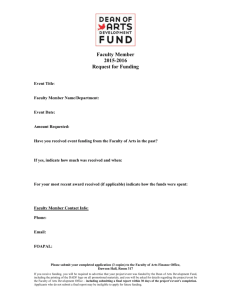
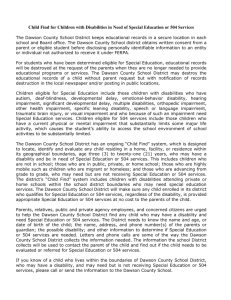
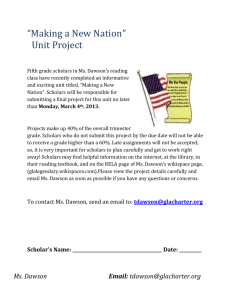
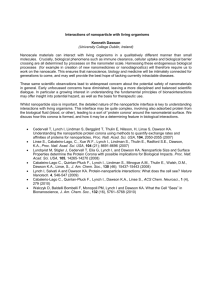
![[[1]] Kew October 28 [18]62 Dear [Asa] Gray I have 3 letters to thank](http://s3.studylib.net/store/data/007337073_1-834cfebf0b7dd89ede752d50251a2d35-300x300.png)
